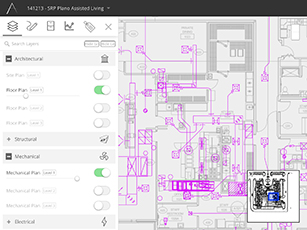
Courtesy Project Atlas
Users at a Bluebeam Inc. conference show off Project Atlas, an application that rethinks how workers interact with site drawings and bases its operations on Google Maps
During the Bluebeam eXtreme user conference in Los Angeles, July 29- 31, amid announcements and presentations, two construction workers talked about the future of construction drawings. Off stage, the workers showed an application they developed called Project Atlas, which aims to eradicate paper-based thinking from construction.
“It’s not about pages anymore,” says Todd Wynne, construction technology manager, Rogers-O’Brien Construction, Dallas. “Why continue to break up our buildings on paper-sized sheets when we’re not building from paper anymore?”
Project Atlas is an application that’s being beta tested by several firms now, says Wynne. It ingests site drawings, stitches them together into a multi-level map and removes the matchlines. As a user zooms in further and further on a portion of a site drawing, info is presented contextually, depending on the level of zoom, says Wynne.
“We’ve built this whole system of documenting projects that hasn’t changed since parchment,” says Joe Williams, director technology, Rogers-O’Brien. “We threw all those rules out the window.”
Williams says the idea developed when he and Wynne began to see site drawings as a map of a building instead of a blueprint. If it were like Google Maps, then different layers of information could be toggled on and off, disciplines color-coded and section cuts and details could all be seen in context, he says. Integrating with Bluebeam is crucial to making Project Atlas a vital tool in the future, adds Williams.
“To have all that data at a superintendent’s fingertips, it could help us tremendously,” says Clifton Cole, BIM Manager, PENTA Building Group.
A superintendent from Pasadena-based contractor C.W. Driver gave a presentation showing how Bluebeam Software Inc. is already bringing data to his fingertips and helping him run a paperless job site.
“It allows me to spend 80% of my time in the field instead of half my time out of the field trying to find information,” says Jim Gentile. His employer developed a dashboard in-house that helps train new users and makes all the documents look the same, a standardization-training dashboard. “Stamping, RFI’s and hyperlinking now look consistent, from one architect to the next, and from one project to the next,” says Gentile. The dashboard and the training made a difference. By treating his company’s projects as a scientific lab, Gentile tracked data from two similar projects, one built with Bluebeam and one without, enabling him to measure the time and money saved.
“On the Santa Monica Bloomingdales we spent $25,000 more on reprographics than the one in Glendale,” he says. “We also saved over 40 hours a month in time, from documents and lost data.” Both jobs used the same project manager.
Bluebeam announced the release of Bluebeam Studio Prime, which comes with an application programming interface (API). The API allows companies to build programs on Bluebeam’s framework, so they can integrate better.




Post a comment to this article
Report Abusive Comment